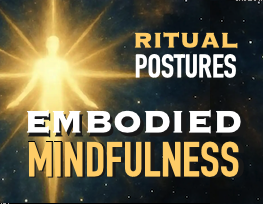 Embodied Mindfulness:
Embodied Mindfulness:
Ritual Postures as a Mindfulness Practice
by Paul Robear
With the growing interest in mindfulness, we are often asked if there’s a connection between these modern practices and the work of the Cuyamungue Institute. The answer is yes, and it lies in the shared ground of presence, intention, and embodied awareness.
Let’s begin with a definition. Mindfulness is often described as a state of active, open attention to the present moment. It invites us into the role of the observer—cultivating presence without attachment to our thoughts and feelings.
Embodied spirituality, in turn, recognizes the body not as separate from the spiritual realm, but as a vital pathway to it. It emphasizes the integration of physical, emotional, and spiritual dimensions of being. The body is not just a vessel but a source of wisdom—a tool for connection, insight, and transformation.
When we speak of embodied mindfulness, we refer to the cultivation of present-moment awareness through direct engagement with the body—sensing not only thoughts and emotions, but also the subtle language of breath, muscle, sensation, and energy.
Why does this matter? Mindfulness cultivates awareness, which in turn reduces stress, anxiety, and reactivity, while enhancing clarity, emotional resilience, and well-being. By training ourselves to witness rather than react, we gain the capacity to meet life with greater compassion, intentionality, and inner steadiness.
At the Cuyamungue Institute, we explore the meeting place of body, spirit, and consciousness through Ritual Body Postures, a unique and powerful form of embodied mindfulness. Like other mindfulness practices, these postures open the door to the present moment. Practitioners are invited to notice bodily sensations, changes in temperature, the rhythm of the breath, and subtle shifts in perception—all without judgment or the need to control the experience. This embodied awareness, feeling the posture in the muscles, sensing the heartbeat, noticing the mind’s quieting—anchors consciousness in the now. The posture becomes a “home base,” much like the breath in seated meditation.
Each session begins with a deliberate positioning of the body. The chosen posture sets the intention and focus of the journey, whether it is insight, healing, ancestral connection, or communion with the sacred. This mirrors how many mindfulness practices begin with an anchor, such as the breath, sound, or physical sensation. The posture becomes more than a shape; it becomes a container for consciousness, a ritual act of presence.
While Ritual Body Postures often open the door to visionary imagery or expanded states of awareness, the practitioner remains grounded in mindful observation. Experiences are met with openness, clarity, and non-attachment. This mirrors the core practice of mindfulness: witnessing what arises without being swept away by it.
A foundational principle of mindfulness, nonjudgmental awareness, is central to posture work. Whatever emerges is welcomed with curiosity, not control. There’s no need to label experiences as “good” or “bad.” Over time, this cultivates trust in the process, deepens self-understanding, and softens the habitual filters of expectation and interpretation.
In posture practice, the body is still, but awareness is alert and deeply engaged. This blend of physical presence, altered-yet-conscious states, and mindful witnessing creates a distinctive pathway into mindfulness—one that is grounded, expansive, and deeply embodied.
Time and again, I have seen how this work brings clarity, emotional release, and a profound sense of inner guidance. Ritual Body Postures are not only an ancient spiritual technology—they also stand as a contemporary mindfulness practice: rooted in the body, open in the heart, and awake in the mind.
In this way, they invite us into a living awareness—a state of embodied mindfulness, where the wisdom of the body meets the stillness of the mind. In this ancient practice, we do not chase the moment—we become it.
